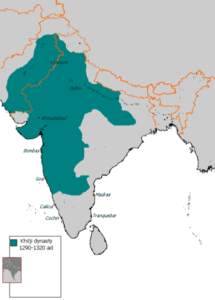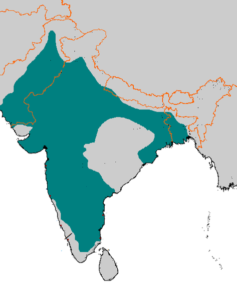Introduction
The Khalji dynasty reigned during the height of the Delhi sultanate, and Allaudin Khalji was credited with most of its accomplishments. He united the entire Indian subcontinent under his reign and was the most powerful sultan of the Delhi sultanate. After slaying his father-in-law Jalaluddin Khalji, the founder of the dynasty, Alauddin Khalji ascended to the throne in 1296. In 1320, the Ghiiyasuddin Tughluq overthrew the Khalji dynasty and established the Tughlaq dynasty. Later, Mohammad Tughluq oversaw the growth of the Sultanate.
Consolidation under Khalji Dynasty
Due to internal strife among the noles, Jalaluddin, the first king of the Khalji dynasty, was unable to extend his territory. He had a brief six-year reign during which he spent time stabilising and legitimising his position and power. Alauddin Khalji, Jalaluddin’s son-in-law, killed him, took the throne for himself, and proclaimed himself the ruler of the Delhi sultanate.
The Delhi Sultanate reached its pinnacle under Alauddin Khalji. Alauddin’s first trip was to Gujrat in 1299. This was his first foray into new territory. He stole the wealth and appointed Alp Khan governor. He continued his westward expansion by attacking Malwa in 1305 and winning a bloody struggle to take the fort of Mandu. He seized control of Chittor, Mewar, and Ranthambore as well as all of western India. Alauddin extended his hegemony into southern India. Wherever he triumphed, he appointed his trusted nobles as administrators.

Administration under the Khalji Dynasty:
The kings of the Khalji people appointed their military leaders as governors and gave them authority over their territory. These territories were referred to as “Iqta” and the owners as “Iqtadar” or “Muqti.” Iqtadars were required to support the king militarily and uphold law and order in their region. Iqtadar received a wage from the money their territories generated. Three different tax types existed. The first tax was imposed on the “kharaj” portion of the crop, followed by a tax on cattle and a third tax on horses. Throughout Alauddin Khalji’s reign, numerous administrative changes were made.
- The empire was divided into provinces, and there were 11 provinces under Alauddin Khan.
- Alauddin established a sizable standing army to defend the country from Mongol intrusion.
- For his troops, Alauddin built the garrison town of Siri.
- He also levied taxes in the Ganga Yamuna doab region to pay for the rations of his soldiers. He set the prices for goods in Delhi; government employees were assigned to monitor this, and those who failed to sell at the set price faced consequences.
- The first emperor to pay his troops in cash was Alauddin. Alauddin had managed the market price so that it stayed constant even during the Mongol invasion.
Consolidation under Tughlaq Dynasty:
The Deccan Sultanate’s rule was not unbreakable; with the death of Alauddin, the southern provinces rose up and gained their independence. The founder of the Tughlaq dynasty, Ghyisuddin Tughluq, was made aware of this. During the brief period of his administration, Ghiyasuddin was unable to subjugate the south to the Delhi sultanate. After assuming power, Mohammad bin Tughluq concentrated his effort on the south. He organised numerous military operations and seized control of a sizable portion of the South.
He went on to Mabar in the south. He conquered Bengal in the east, which had declared itself independent because of its separation from the Delhi sultanate and the difficulty of maintaining administration and consolidation at such a distance.

Mohammad Tughluq organised a number of far north and northwest missions. After suffering a severe defeat in Tibet with his troops, he planned the Qurachi expedition but later abandoned it. The Delhi Sultanate’s largest domain belonged to Mohammad Tughluq, and this contributed to the sultanate’s demise.
Administration under Tughlaq Dynasty:
The Tughlaq dynasty preserved the empire while carrying out the majority of Khalji’s administrative principles. Nobles were given the authority to collect taxes from their iqta as part of the tradition of iqta. Bandagan continued to be appointed as governor and military commander under Tughlaqs. Specially trained slaves called bandagan were loyal only to the King. Some rules imposed by the king were highly controversial. He appointed gardeners, cooks, and wine distillers to high administrative posts at once. The noles were harshly critical of the ruler’s unorthodox methods.
- To stop the Mongols from capturing their empire, Mohammad established a powerful standing army.
- His victory over the Mongol invasion. Instead of building a new garrison town for the army, he dispersed its population to Daulatabad and stationed his soldiers in an old Delhi neighbourhood.
- Taxes were raised to provide for the troops.
- People started to feel unsatisfied as a result.
- At the same period, north India had a famine.
- His attempt at token currency, which was made of cheap metal and was simple to reproduce, failed horribly.
- Taxes were paid with token money, and gold was kept.
Summary
The Khalji and Tughlaq dynasties represented the height of the Delhi sultanate. The Khalji monarch Alauddin implemented strict laws and regulations to manage his enormous realm. He was an astute administrator who worked hard to keep Delhi’s commodity prices stable. The Tughlaq dynasty inherited Khalji’s administrative and expansionist objectives. Mohammad Tuhghluq, the most well-known king of Tughlaq, introduced many radically new administrative reforms and conducted numerous policy experiments. Unfortunately, he had short-sighted policies and was a hasty and irritable ruler, which led to the slow decline of his kingdom.
Frequently Asked Questions
1.What were Muqtis’ Responsibilities?
Ans. Muqties were required to uphold peace and order in their iqtas as well as provide the emperor with military support. Muqties were permitted to deduct taxes from his iqta in exchange for their services.
2.Who were the Chieftains?
Ans. Chieftains were another name for Samanta nobility. They were wealthy landowners who lived in the countryside, and the empire brought them under its control and taxed them.
3.What is Accurate in terms of Governance and Unification under the Khaljis and Tughlaqs?
Ans. Even though these dynasties ruled over the majority of the Indian subcontinent, most of the interior remained independent. The hardest part of managing all the provinces was the distance, and remote areas like Bengal were tough to manage.
 Mission Statement
Mission Statement
“Empower every student to achieve full potential”
88Guru has been established with the social objective of making quality video-based learning material available to all Indian students. Technology, Connectivity and Social Media are rapidly changing the world of Education and we wish to lead the transformation of the tuition industry in India.
88Guru is the perfect complement to the current tuition model. 88Guru creates a wonderful opportunity for children and parents to bond while engaging in a valuable learning activity. It also provides the complete curriculum at your fingertips for those moments when you need some help at short notice. We believe that this mode of tuition could be transformational, adding hours to a child's day while providing complete control over the learning process.
Every course is taught by the best teachers from India's top schools and conducted in an engaging manner to keep students involved. The e-learning process consists of video-based instructions, computer-graded assignments, and a dashboard which allows the student and parent to track progress.


